| Article ID | Journal | Published Year | Pages | File Type |
|---|---|---|---|---|
| 6412571 | Journal of Hydrology | 2014 | 11 Pages |
â¢Approaches to freshwater leakage through aquitards in sharp-interface models are tested.â¢Interface position and vertical fluxes are compared for sharp-interface and dispersive models, and sand-tank experiments.â¢The assumption of freshwater leakage bypassing overlying saltwater best matched both tank-scale and field-scale aquifers.
SummaryPrevious sharp-interface studies of seawater intrusion (SWI) adopt various approaches to the treatment of vertical fluxes in regions where alternating saltwater and freshwater are found in overlying aquifers. In this study, we compare dispersive modeling and sand-tank experiments to the results of sharp-interface models to evaluate assumptions regarding vertical fluxes in coastal multi-aquifer systems. The sand-tank experiments (one transient and two steady-state cases) consist of two coarse sand layers separated by a lower-permeability layer of fine sand. Vertical freshwater leakage in sharp-interface models is treated in one of three ways. Case 1: upward freshwater leakage flows only into freshwater in the aquifer above, bypassing any overlying saltwater; Case 2: no upward freshwater leakage occurs if there is overlying saltwater; Case 3: freshwater leaks into any overlying saltwater without modifying the saltwater salinity. Sharp-interface models over-predicted the toe position of the saltwater wedge in both the experiments and numerical models (regardless of the vertical leakage assumption), in agreement with previous studies. Nonetheless, Case 1 produced improved prediction of the sand-tank results relative to Cases 2 and 3. Freshwater leakage fluxes in areas where the interface was absent were reasonably well represented by all three sharp-interface leakage assumptions, compared to those of the dispersive model. In regions where saltwater overlies freshwater, the upward freshwater fluxes predicted by dispersive modeling were found to be consistently closest to the upward freshwater flux of Case 1, compared to Cases 2 and 3. Saltwater-to-saltwater leakages from the dispersive models were poorly represented by the sharp-interface models. Vertical flux assumptions were then evaluated for idealized field-scale situations, and Case 1 again best matched the dispersive modeling results. Streamlines from dispersive modeling show that upward freshwater leakage tends to flow around and bypass overlying saltwater. This matches optimally the assumption of Case 1. We conclude that Case 1 is the ideal approach to the treatment of upward freshwater fluxes in sharp-interface models of multiple-aquifer systems, whereas Cases 2 and 3 may create unrealistic SWI predictions, especially for situations where overlying aquifers are separated by a layer of low conductance.
